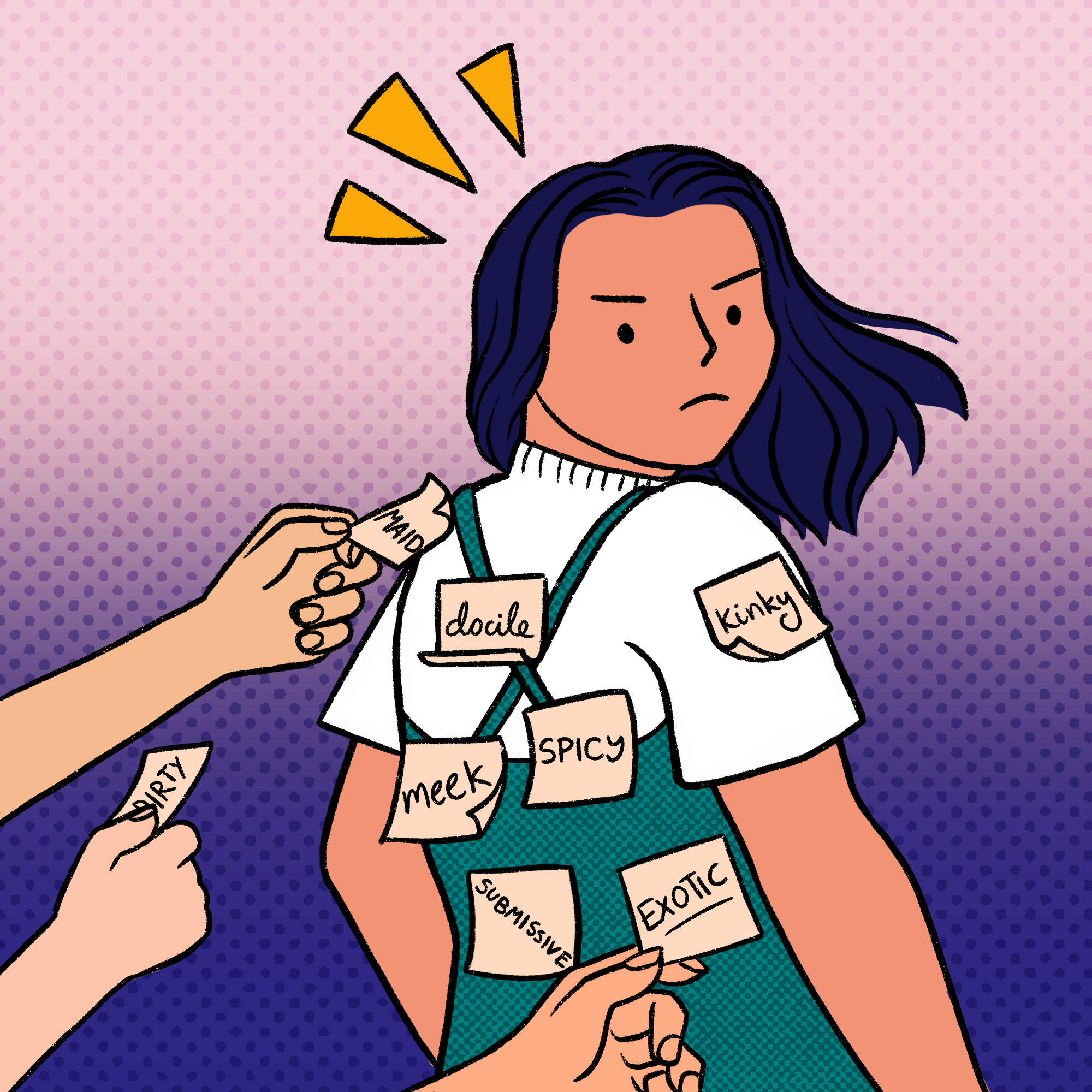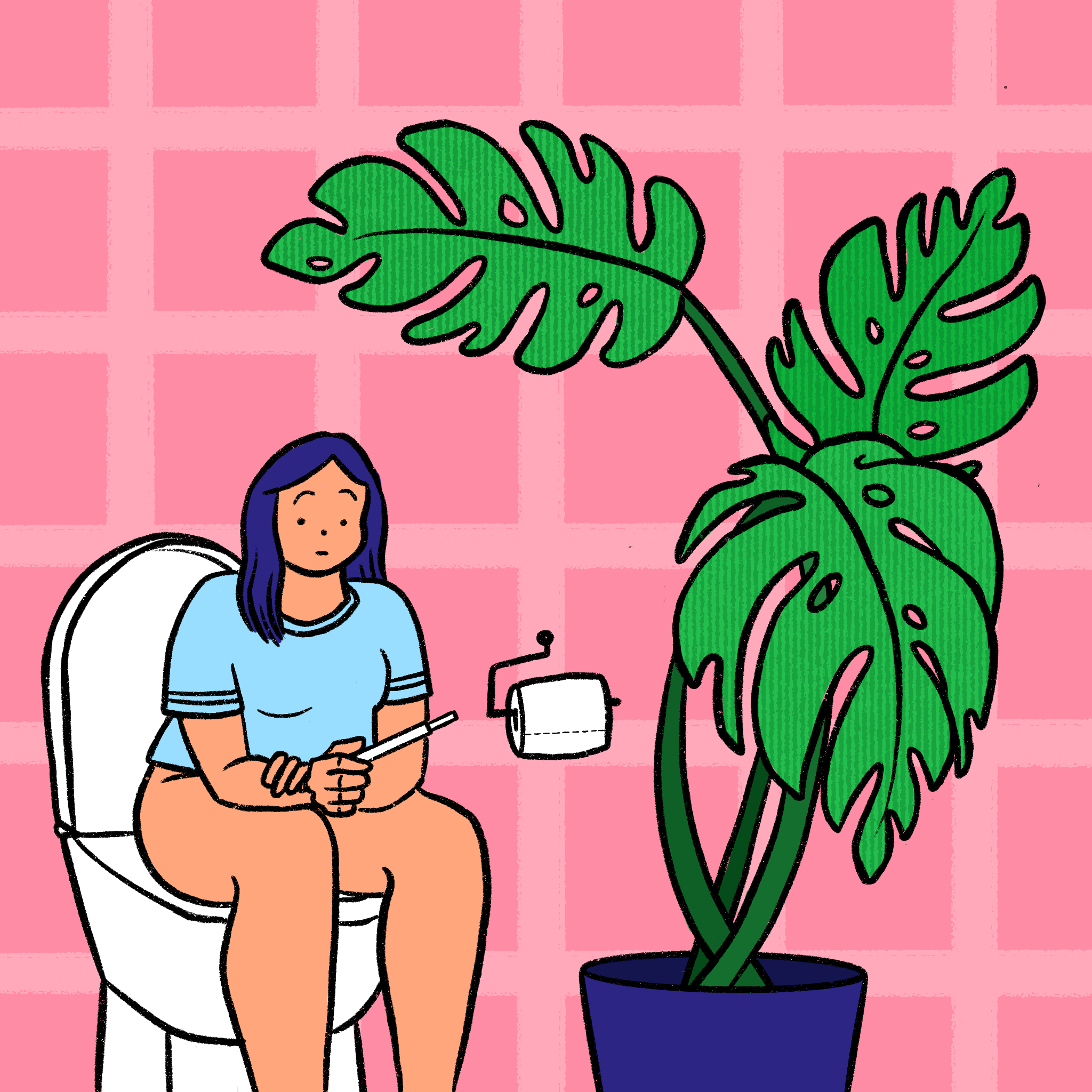I'm Not Your Spicy Señorita
And I'll reclaim your stereotypes on my own terms.
Illustration by Ally Hart
I’m biethnic. Mexican and Filipino to be exact, but I look more Hispanic than anything. Proud to be a part of two beautiful cultures, I don’t identify as one over the other. But growing up, I began to look the part of a curvy, dark-haired Hispanic woman more and more. No longer a little girl, I grew into my womanhood with pre-existing notions of how I should be. Sofia Vergara in Modern Family dictated that I had to be passionate, fiesty, and beautiful all at the same time in order to be a real Latina. The idolization of JLo meant that I had to have a big butt to qualify as a hot Latina. These static expectations were everywhere and it was hard to not feel their influence.
At the same time, my Asian background largely remained just that: the background to my Hispanic looks. But we can’t just ignore my Asian side, so where does that put me? According to stereotypes of Asian women, I’m beholden to the expectations of being quiet, submissive, and docile. Asian women are fetishized and exoticized, often by the (racist) white community. So simply due to being both Asian and Mexican, I’m automatically labeled as sexual and spicy yet submissive and sweet. And if I stray from these one-sided views, I’m then no longer a real Asian woman or Latina. Why are these stereotypes so ingrained in our culture? Where did these stereotypes even come from?
Latino stereotypes can be traced all the way back to the 1800s, especially with the beginning of the Mexican-American War in 1846. The war – a dispute between the Mexican and U.S. governments over Mexican land – resulted in the Treaty of Guadalupe Hidalgo in 1848, which gave the U.S. control over a large chunk of land, including Texas, California and Nevada, establishing the Rio Grande as the U.S.-Mexican border. After the war, there was a surge of patriotism in the U.S. coupled with immense anti-Latino sentiment. I say Latino here (instead of Mexican) because the identities of various Latin Americans became blurred and lumped into one in the eyes of white Americans. During this time, white Americans began to forcibly take over land previously and rightfully owned by Mexican citizens. To justify these actions, Americans, backed by the American government and Manifest Destiny, had to see and perpetuate the idea of Mexicans as less than. Latin Americans were labeled as job stealers, uneducated, criminal and lazy, despite being hard workers who contributed hugely to the U.S. economy. Seeing Latin Americans in this light made it easier to steal their land and even resort to lynching. Racist ideology against any non-white, non-English speaking people spread quickly, as did violence against Mexicans and other Latin Americans.
Negative stereotypes and ideas of Latinos were further perpetuated in the media. At that time, this meant newspapers and Hollywood films portraying Mexicans as rapists, criminals, banditos, and greasers. In fact, the term greaser became synonymous with Mexican in racist white discourse. Mexican film characters were so clearly offensive and racist that in 1922, the Mexican Government threatened to ban all movies made by studios that had released these kinds of insulting films. Hollywood backed off, but only briefly and slightly. To this day, Latinos are still largely used to play drug lords or other low-life characters.
At the same time when Mexican men were being portrayed thus, Lupe Velez was making her way up the Hollywood ladder. She began her career in Mexican vaudeville in the 1920s before breaking out into the American film industry. Her first feature film was the 1927 hit The Gaucho, followed by Stand and Deliver (1928), Lady of the Pavements (1929) and Where East Is East (1929), where she played a Chinese woman – more on this later. Clearly, her “otherness” served her well, as did her characters, who were feisty with a sexual manner. By the 1940s, she had earned the nickname “The Mexican Spitfire” due to her headlining a series of films by the same name, along with a range of other nicknames including “Mexican Hurricane,” “The Mexican Wildcat,” “The Mexican Madcap,” “Whoopee Lupe,” and “The Hot Tamale.”
The 1940s also saw “The Brazilian Bombshell,” Carmen Miranda, break into the Hollywood scene with her “exotic” outfits and large fruit hats balanced atop her head. As with Lupe Velez, Miranda’s Brazilianness was easily blurred in her films and, to Hollywood’s white executives and audiences, she became representative of all Latin culture. Velez and Miranda, despite owning their own image and identity, were typecast into those roles and were not allowed to stray outside of them. With these two beautiful, animated, and hypersexualized Latina women as the “face” of Latin culture, it was easy for Americans to associate their characteristics with all Latinas. It was easiest, although unfair, to simply assume that all Latinas must be this way, too.
Unlike these stereotypes of Latinas, which came about largely from media representation, stereotypes of the Asian woman stem more from history. Again, we go back to America in the mid-1800s when the first Chinese immigrants began to arrive. Mostly Chinese men, many of these immigrants could not afford to marry or bring their wives and families with them. Culturally, there were limitations on women traveling alone, not to mention the anti-Chinese violence that was also brewing within America. For those women who did make it to America, job choices were slim. Many women were forced into sex work in order to survive. The male to female discrepancy was so large in 1850 that there were only 7 Chinese women in San Francisco versus over 4,000 men. Without a solid gender ratio, more and more men began frequenting Chinese brothels, increasing the demand for sex workers. By 1870, over 61% of Chinese women in California were listed as prostitutes. Clearly a steady business, the increased demand for female sex workers resulted in immense human trafficking operations where Chinese women were tricked, abducted and coerced into prostitution. Although these women were forced into submission and to sell their bodies for sex, this widespread practice gave way to the misconception that all Asian women were easy, docile, and kinky. To add insult to injury, white America soon caught wind of these Chinese brothels and prostitutes and were quick to label Chinese women as “dirty” and “immoral.” Female prostitutes, not the men who fueled the industry, were blamed for corrupting American values and spreading diseases.
Then in the wake of World War II, American troops began arriving in Japan. Soon, Japan created an expansive network of brothels to provide cheap sex for American soldiers fighting abroad. The Japanese government, by way of Japanese police departments and with the approval of U.S. officials, brought tens of thousands of Asian- most commonly Korean- women to these brothels to sell their bodies to hundreds of men a day. They became known as “comfort women” (translated from the Japanese word “ianfu,” a euphemism for “prostitute”). Already seen as “exotic” and “other” to Americans, these Korean “comfort women” were forced into subservience by the trade and by their own poverty.
This wasn’t just an occurrence in Japan. With the Korean War soon after, almost 300,000 South Korean women were employed as sex workers by 1958. These women worked in “camptowns” centered around American bases and catered to American soldiers. These operations were encouraged by the Korean government, with officials urging American men to spend their money and praising Korean women for being “patriots” for selling their bodies. The practice of setting up brothels around American bases and bars and selling Asian women’s bodies continued during the Vietnam War. The country’s sex industry boomed, profiting everyone but the women sex workers. Coerced, threatened, penniless, and with nowhere to go, millions of Asian sex workers were forced into submission. Sadly, this practice still remains strong today through human trafficking and mail-order bride networks. Asian women have been forced to play up their sexuality and to give their bodies for American men’s pleasure in order to survive. We even see it today with the Asian fetish in the porn industry, more Asian female bodies for profit, feeding the male fetishization of their small features, docility, and “exoticness”; a modern day example of just how big of an audience Asian women’s sex generates.
As with Lupe Velez, Carmen Miranda, and the “spicy” Latina, media representation plays a huge part in the perpetuation of Asian women stereotypes. Stories like Memoirs of a Geisha and The World of Suzie Wong show their Asian protagonists as meek women who must use their bodies for gain. NBC recently thought it a good move to greenlight a show entitled Mail Order Family in which a white American male sends for a mail-order wife from the Philippines to help raise his two teenage daughters. Needless to say, this was not a good move and the studio quickly nixed the project. However, highlighting human trafficking for a comedy sitcom is in no way hilarious. The show was merely an outlet for their Asian fetish to run wild for a national audience.
With white men at the helm, the media industry serves as an outlet and a lens for men’s fantasies about Asian women. It does not allow for any room to be made for a fully realized Asian woman, she who is smart in her own right. This limits audiences’ views of Asian women, first lumping multiple nationalities into one and also by dictating that all Asian women fit the bill. This is not unlike the lumping of Latinx identities mentioned earlier or even the use of Lupe Velez as a Chinese woman in Where East Is East (1929). Even further, it limits opportunities for Asian women to express themselves. Not all Asian women are docile, nor do they want to be. Not all Asian women are comfortable being hypersexualized, and those women who do “fit the bill” may feel conflicted that they are seemingly perpetuating the stereotype. This is where the harm of stereotypes comes in.
So how does someone like me reconcile these two conflicting and highly problematic representations of such women of color? How do I present myself to the world as someone who is more than the Manhattan Maid, the Combustible Columbian, or the Silent Sex Slave?
Often, when someone is confronted with their usage of racist stereotypes, they argue that stereotypes are either funny, convenient, true, or even complimentary. But joking about Filipino women as only being good for mail-order brides or as maids isn’t funny when the “joke” stems from real pain and exploitation of real women. My family is not here for your fetish nor to be the butt of a bad joke. Filipinas are beautiful in their own choices of sexuality, beautiful for their choices in music, and beautiful in the way they cook and care for those around them.
Someone else might even counter with: what woman doesn’t want to be seen as hot-blooded and attractive? These kinds of questions and assumptions are unfair. Painting every Hispanic woman into a corner and expecting a one-sided stereotype from her does not give her any room to be her own person. I can be sexual, but I can also be shy. Sometimes I prefer reading a book to shaking my hips. My aspirations reach higher than being your exotic fantasy or housemaid.
These stereotypes were created to paint me into a corner; to deny me a real and unique identity. But you know what? I come from a family full of Filipina doctors, nurses, writers, physical therapists, probation officers, and more. We read and trade books we’ve enjoyed with each other. We are more than subservient wives here to cater to a white man’s whims. My Mexican aunts are beautiful in the way they joke and laugh, in the way they make sure everyone is having a good time and feeling loved. We are caring and strong mothers, aunts, and daughters. We refuse to accept those notions quietly. We will not play into those stereotypes in order to make you feel comfortable or to fit into a weak idea of what we should be. So to NBC and all those avide subscribers to AsianPorn.com, I am NOT your Spicy Senorita, and I sure as hell am NOT your mail-order bride.














